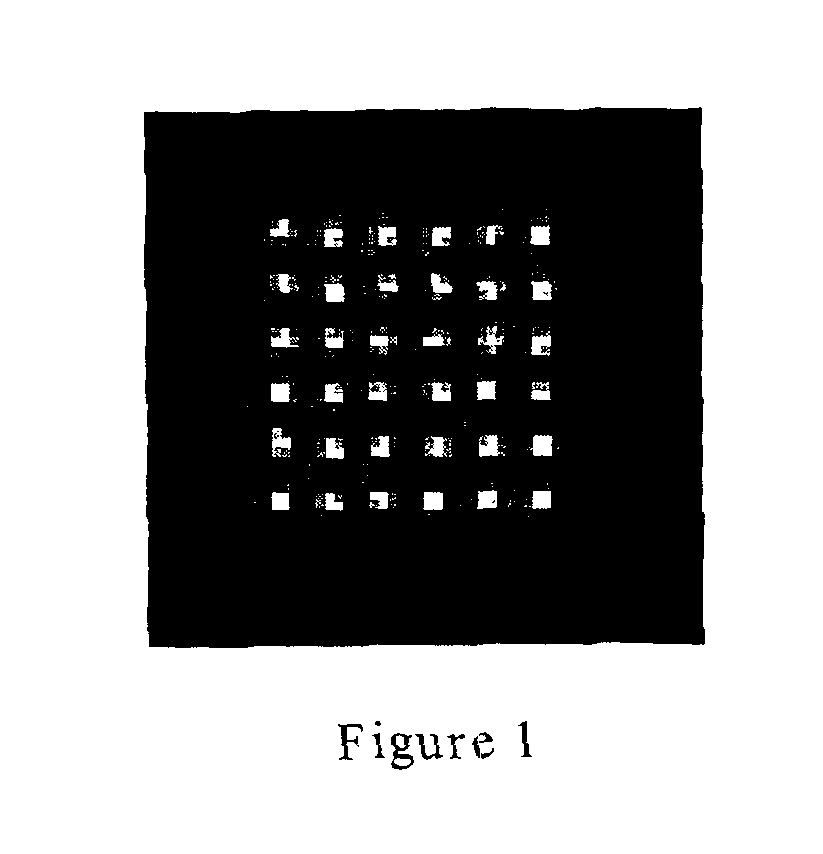Analysis using a distributed sample
a distributed sample and microarray technology, applied in the preparation of sugar derivatives, peptide/protein ingredients, depsipeptides, etc., can solve the problem of stringency control of hybridization reactions, difficult detection of low copy number (i.e., 1-100,000) nucleic acid targets, and significant decrease in the number of hybridized probe/target complexes for detection
- Summary
- Abstract
- Description
- Claims
- Application Information
AI Technical Summary
Problems solved by technology
Method used
Image
Examples
example 1
[0072]A sample can be dispensed in picoliter volumes with reasonable accuracy. Thus, a single “unknown” sample can be rapidly distributed to thousands of locations in sufficient quantities with precision. For example, the distribution of 1 microliter of sample at 1000 locations requires the delivery of 1 nanoliter (nL) (1000 picoliters) to each site. This is possible with current technology. By comparison, a conventional 1536 microtiter plate would require the use of about 2 milliliters per plate. A typical gene expression experiment on a microscope slide employs 10-15 μL of sample. Thus, a 15 μL sample would allow the distribution of about 10 nL to each well (15,000 nL / 1500 wells).
[0073]Currently, a reasonably sized sample contains 1-2 μg mRNA (1000-2000 ng). If 15 ng in a 15,000 nL sample is distributed equally over 1500 wells, then 10 nL containing 1 ng is placed in each well (1500 ng / 15,000 nL)×10 nL). This amount of nucleic acid can be detected by the use of labeled probes with...
example 2
[0074]A Human IgG sample was evenly distributed onto 200 μL aliquots, each containing approximately 1 femtomole of protein. The protein was covalently attached onto an acyl fluoride-activated polypropylene substrate. The sample was developed using an anti-Human IgG-alkaline phosphatase conjugate. Signal was generated using the ELF reagent. The developed microarray is shown in FIG. 1. In this example, a 3% CV (coefficient of variation) was obtained for the mean signal intensities of the 36 distributed sample aliquots. Thus, the sample was successfully dispensed and subsequently immobilized to the surface into equivalent elements of the microarray.
PUM
| Property | Measurement | Unit |
|---|---|---|
| diameter | aaaaa | aaaaa |
| metallic | aaaaa | aaaaa |
| adsorption | aaaaa | aaaaa |
Abstract
Description
Claims
Application Information
 Login to View More
Login to View More - R&D
- Intellectual Property
- Life Sciences
- Materials
- Tech Scout
- Unparalleled Data Quality
- Higher Quality Content
- 60% Fewer Hallucinations
Browse by: Latest US Patents, China's latest patents, Technical Efficacy Thesaurus, Application Domain, Technology Topic, Popular Technical Reports.
© 2025 PatSnap. All rights reserved.Legal|Privacy policy|Modern Slavery Act Transparency Statement|Sitemap|About US| Contact US: help@patsnap.com

